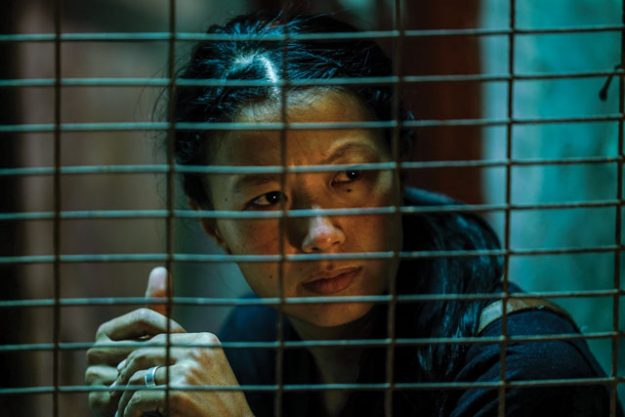Labored breathing billows from figures wading through snow. The sound of gunfire rings from a distance. One of the figures collapses, and a father carrying his 8-year-old daughter whose cheeks are cracked with frostbite rushes to their aid. The episode flickers out, and the film cuts to the beating heart of a Tibetan refugee settlement in North Delhi.
The opening sequence of The Sweet Requiem, a new feature drama by activist filmmakers Ritu Sarin and Tenzing Sonam, reads like the first few verses of a classical Buddhist text. It begins with an homage, however unorthodox, followed by a pledge to compose. In this case, respects are paid indirectly to the Tibetans who were killed and injured in a widely reported 2006 incident at Nangpa La pass, when Chinese guards opened fire at a group of refugees attempting to cross the border into Nepal. As for creative motivation, it was the desire to open up dialogue about the complex realities of what it’s like to be a refugee, says the husband-and-wife director duo.
The story line picks up 18 years later, but under less dire circumstances. Dolkar, the little girl who fled Tibet with her father, is celebrating her 26th birthday with friends in a cramped apartment. She is working hard to build a normal life for herself in Delhi, where she makes ends meet as a threader in a beauty salon and moonlights with a human rights organization that helps resettle Tibetan Buddhist refugees.
It’s clear from the start that Dolkar (played by first-time actress Tenzin Dolker) is a young woman caught between two worlds. Isolation and unresolved grief hang over her present life like the thick smog that enfolds Delhi, itself a character with its own moods and muted fluorescent color scheme. But it’s Dolkar’s opaque past, which unfolds in a series of dreams and flashbacks, that provides most of the film’s intrigue and tension.
A community vigil held at the local monastery brings Dolkar together with a strangely familiar man named Gompo (Jampa Kalsang Tamang). He’s a recent arrival from Lhasa who we later learn is on the run from Chinese security forces for charges of murder and treason. Dolkar’s interest in Gompo, who she believes abandoned her family on their harrowing escape from Tibet, becomes obsessive. Against her better judgment, she starts following him down dimly lit alleys, dipping into shadows to watch him for hours, sometimes days at a time. All the while, she is convinced that Gompo is not the political activist he claims to be but is actually working as a spy for the Chinese.
After their encounter, memories from Dolkar’s childhood begin to haunt her with increasing intensity. And from here on out her reality starts to splinter, becoming dreamlike at times, an effect that magnifies the psychological thriller’s neo-noir and Buddhist undertones.

Reality continues to bend as more fragments of Dolkar’s journey gradually come into view. In an early flashback, the camera pans to a wide-angle shot of the Tibetan plateau, a refreshing break from the claustrophobic and overwhelming streets of Delhi. A traditional yak-hair tent sits at the edge of a pasture in an unforgiving mountain range. Inside, Dolkar overhears her parents talking softly about the difficult decision they must make.
“So many Tibetan children have left for India,” her father, Migmar, whispers to his wife. “The Chinese have moved into our pastures. What kind of life can we offer them here?” At daybreak, in one of the movie’s more emotional moments, Migmar and Dolkar leave their family and everything they know behind. Their departure points to an ongoing crisis facing modern-day Tibet. Since the Chinese invasion in 1959, generations of children have been sent by their families to India in order to receive a Tibetan education, and very few are able to return. Far fewer ever reconnect with their families.
The Sweet Requiem is not the first work by Sarin and Sonam to deal with the themes of exile, identity, and longing for one’s homeland. Unlike Dreaming Lhasa (2005), their second drama is less focused on delivering an urgent political message, though there is plenty of nationalism and nostalgia. Instead, it concentrates on what the day-to-day rebuilding process looks like for refugees, and how they cope with loss.
Frequent and abrupt cuts between Dolkar’s past and present imitate the way that trauma can hijack the mind. Structurally speaking, this is one of the film’s greatest strengths. Derailed by Gompo’s arrival, Dolkar retreats further into herself, refusing to let others in and forgoing social plans while she streams heartbreaking video loops of self-immolations. Even her own attempts to find ground and healing at dance classes leave Dolkar feeling disconnected and detached.
The Sweet Requiem concentrates on what the day-to-day rebuilding process looks like for refugees, and how they cope with loss.
But her disconnect is not just emotional; it’s also a result of Chinese control and censorship. Dolkar repeatedly calls home only to be mocked by an automated Chinese interception, except for the one time she is able to reach her sister. Gompo, too, is reminded of who’s in charge by two menacing Chinese spies who detain him in several white-knuckle sequences. “Your activities are like an ant biting an elephant,” they tell him, referring to the power wielded by the Party.
In quieter moments, the camera homes in on Dolkar offering incense in front of a framed photograph of His Holiness the Dalai Lama. Hanging beside the modest shrine is a poster made up of headshots of Tibetans who have self-immolated. She lets the match’s flame linger a few seconds too long, as if to feel their desperation on her own skin. At other times, she studies her reflection in the mirror, caressing the dzi bead strung around her neck. It’s an understated shot, but the stone functions like an evil eye in Tibetan culture. It is also a repository for memories and karma, and for Dolkar, it’s an heirloom that connects her to her ancestry.
The Sweet Requiem invites Tibetan viewers in the diaspora to “externalize and discuss some of the trauma and suffering we carry silently within us,” Sarin and Sonam say about their wider goals for the movie. And for international audiences, the film is a reminder of the hardships Tibetans have endured over their six-decade struggle for freedom. Instead of turning away, we are encouraged to take steps toward developing a more compassionate understanding of their situation. Likewise, this one portrait clues us into the complicated bardos—neither here nor there in-between states—experienced by refugees worldwide.
Apart from some stilted dialogue, a central romance that never heats up, and side characters who fall flat, The Sweet Requiem does justice to its title. Alone together in the end, surrounded by the ghosts of their past, Dolkar and Gompo find in each other hope for reconciliation and healing.
Thank you for subscribing to Tricycle! As a nonprofit, we depend on readers like you to keep Buddhist teachings and practices widely available.
